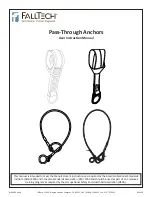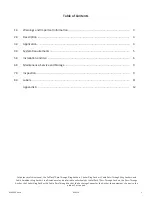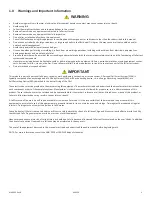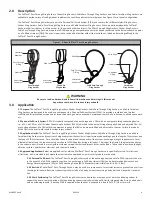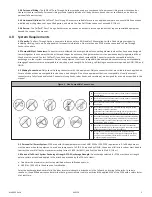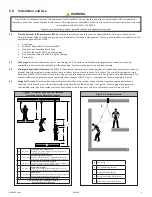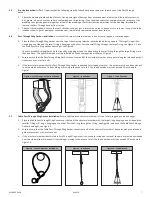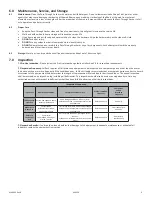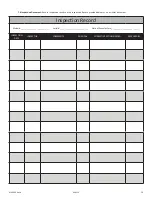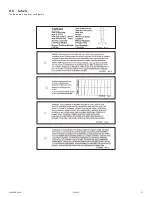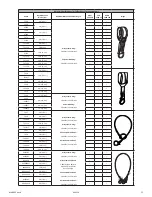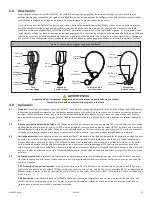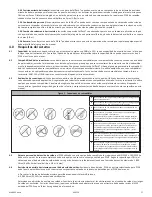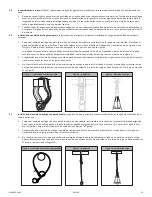
5.0 Installation and Use
WARNING
Do not alter or intentionally misuse this equipment. Consult FallTech® when using this equipment in combination with components or
subsystems other than those described in this manual. All components or subsystems used with the anchors discussed in this manual must be
in compliance with ANSI Z359 or CSA Z259.
Take action to avoid sharp and/or abrasive surfaces and edges when possible.
5.1.
Plan the Personal Fall Arrest System (PFAS): Examine the work area and take action to address hazards. Falls are a serious hazard
when working at height. Training and equipment are the tools of fall hazard management. There are several closely related facets of fall
hazard management with a PFAS;
•
Anchorage
•
Minimum Required Fall Clearance (MRFC)
•
Swing Fall and Expanded Work Zone
•
Overhead (above the FBH D-ring) Anchorage
•
Non-overhead (below the FBH D-ring) Anchorage
•
Rescue Plan
5.2
Anchorage: Select a suitable anchor point. See Paragraph 4.6. To avoid an unintended disengagement of connectors, use only
compatible connectors when connecting to the anchorage. Ensure all connectors close and lock securely.
5.3
Minimum Required Fall Clearance: The MRFC is the minimum distance a user needs between himself and the nearest obstruction (or
ground) below the walking/working surface to avoid serious injury or death in case of a fall event. The user of this equipment must
determine the MRFC for units discussed in this manual to ensure adequate clearance exists in the fall path. Variables discussed in this
manual include the height of the anchor point relative to the user’s FBH D-ring, i.e., overhead, see Lanyard example in Figure 3.
11
22
33
A
B
C
D
E
F
A
6 ft (1.8 m)
Length of Shock Absorbing Lanyard
Original working length before a fall event occurs/before
activation of energy absorber
B
4 1/2 ft (1.4 m)
Elongation/Deceleration Distance
Maximum allowable amoung of elongation that may payout
from the energy absorber upon activation during a fall event
C
1 ft (0.3 m)
Harness Stretch and Dorsal D-Ring Shift
Combined amount of harness webbing elongation and dorsal
back D-Ring up-shift during entire fall event
D
5 ft (1.5 m)
Height of Dorsal D-Ring
Typical average height of the dorsal D-Ring on a user’s full
body harness, measured from the walking/working surface up
E
1 1/2 ft (0.5 m)
Safety Factor
Added length for other factors such as an improperly adjusted
harness, actual worker height or worker weight
F
18 ft (5.5 m)
Total Minimum Clear Fall Distance Required
1. Overhead Anchorage 2. Walking/Working Surface
3. Nearest Lower Level or Obstruction
Figure 3 - Minimum Required Fall Clearance
Overhead Energy Absorbing Lanyard
MANC03 Rev B
040320
6
Figure 4 - Swing Fall Hazard
A Anchorage
B Energy Absorbing Lanyard
C
Walking/Working Surface
D Swing Fall Impact After Fall Event
E
Next Lower Level or Obstruction
5.4
Swing Fall: A swing fall occurs when the worker moves laterally out from under the anchor and creates an expanded work zone
condition. If a fall event occurs, the worker would swing back toward the anchorage, see Figure 4. The swinging action generates
considerable force, and if the worker strikes an obstruction or the lower level, this force could cause severe injury or death.
Содержание 7324
Страница 11: ...8 0 Labels The labels must be present and legible MANC03 Rev B 040320 11...
Страница 23: ...8 0 Etiquetas Las etiquetas deben estar presentes y ser legibles MANC03 Rev B 040320 23...
Страница 35: ...8 0 tiquettes Les tiquettes doivent tre pr sentes et lisibles MANC03 R v B 040320 35...

